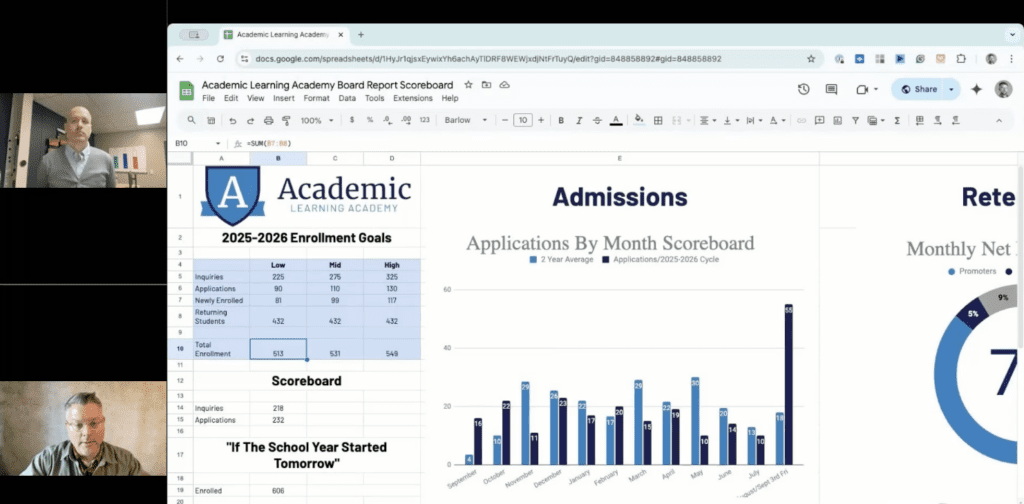Reporting to the Board: How to Present Marketing & Enrollment Data With Confidence
Empowered Enrollment Team
For many marketing and enrollment professionals, reporting to the board can feel like navigating uncharted territory. You’re expected to present on your progress, but no one ever taught you what to share (or how to share it). Should you do a verbal report? A narrative? How many slides should you include in a deck? How much time should you prepare?
Whether you’re new to your role or have been in it for a few years, it’s easy to feel overwhelmed or even intimidated when presenting to school leadership.
In this webinar recap, you’ll learn the essentials of presenting data-driven reports, as presented by Andy Lynch, President and CEO, and Rudi Gesch, Director of Marketing, as they explore how you can build stronger understanding between your team and school leadership.
Why Board Reporting Matters
The board’s role is to provide oversight and guidance to the school’s leadership. As a result, some teams might view board reporting with apprehension.
“Your perception of the board might be these mythical, magical creatures in some faraway boardroom with the power of life and death in their hand,” Andy joked. “But the reality is, board members are there because they want to see the school win. They’re not getting paid to do this. They are for you, and they want to support you as best they can.”
Reporting to the board fosters alignment and transparency while creating opportunities for strategic investment in enrollment efforts — things that are essential in a school with healthy enrollment.
“If your board knows you and trusts you, and if you have a track record of credibility, you’re more likely to get the additional resources you need when it comes time to make that request,” Rudi emphasized.
Types of Board Reports
Andy and Rudi outlined two primary types of board reports that every school should consider:
- Annual Presentation
The purpose of this type is to establish overarching goals and strategies in alignment with the school’s financial and enrollment objectives. This might be a 10- to 15-minute presentation, delivered before budget discussions, and include the following:- Enrollment Goals: A three- to five-year trend analysis, with recruitment and retention targets.
- Seasonal Priorities: Key projects and promotions that align with enrollment objectives.
- Projections: Low, mid, and high projections to help boards prepare for various scenarios.
“This is about leading the leaders,” Rudi explained. “You’re the expert on enrollment trends, your school’s position in the marketplace, and what it takes to achieve growth. This is your opportunity to set the tone for the year ahead.”
- Regular Status Reports
In addition to an annual presentation, you should be updating the board throughout the year to maintain alignment and transparency. These reports can be included in the agenda of monthly or quarterly board meetings, requiring minimal explanation, and include the following:- Updated KPIs: Inquiries, applications, and retention rates.
- Visual Dashboards: Clear, concise data presentation.
“When I share a regular status report to the board, it’s straightforward because of the groundwork we’ve laid,” Rudi explained. “At the annual report, I outline what I’ll be reporting on throughout the year. For the regular meetings, the enrollment report is included in the board’s agenda, and they already have access to the data. So when we meet, I can simply say, ‘You have the enrollment report before you — does anyone have any questions?’ It’s the regular cadence and transparency that ensure the board stays consistently informed.”
Building an Effective Dashboard
“Earlier in my career as I was trying to figure out the best way to report to the board, I leaned on narrative reports,” Rudi said. “I found these to be an inefficient use of my time. I switch to a data-driven format that updates automatically. It saves time and ensures I’m focused on moving the needle where it matters.”
Rudi encouraged schools to simplify the process of narrative reporting by developing a visual dashboard that includes:
- Enrollment Goals: Display low, mid, and high projections to set expectations.
- KPIs: Track inquiries and applications against two-year average for context.
- Net Promoter Scores (NPS): Measure family satisfaction monthly to gauge retention trends.

“This is representative of working on your position, not just in it,” Andy added. “It takes thought and preparation, but the payoff is clarity and credibility in your reporting.”
Practical Tips for Success
While it can be tempting to tell the board what you want them to hear, Andy encouraged schools to tell the board what they need to hear with these five tips.
- Align With Leadership: Work closely with your Head of School to ensure reporting priorities align with the school’s strategic goals.
- Be Transparent: Even if your numbers aren’t where you want them to be, honest reporting builds credibility and helps make the case for additional resources.
- Automate Where Possible: Set up systems that streamline data collection and visualization, so updates are quick and accurate.
- Focus on Key Metrics: Regularly review and refine your KPIs to ensure they reflect your school’s priorities.
- Be Prepared for Questions: Familiarize yourself with your data and practice presenting it confidently.
Ready to present your next board report with confidence?
Fill out the form below to download the Board Report Scoreboard resource, as outlined in the webinar.
Explore additional healthy enrollment™ strategies and contact one of our solutions advisors to learn more.


